|
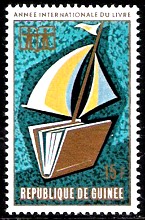
|
Maritime Topics On Stamps :
Maritime Literature !
|
|
The Greek poet Homer lived during the 8th century B.C. and became
famous for authorizing the epic poems 'The Iliad' and 'The Odyssey'.
'The Odyssey' tells the story of the ten year voyage and the safe
return of Ulysses after the fall of Troye. During this voyage he had
to pass the rocky shores of the sirens. This scene is depicted on the
Greek stamp to the right. You can see Ulysses tied to the mast, as the
sirens where known to lure sailors to jump overboard with their songs.
The ears of his crew were stuffed with wax as well. Thus prepared,
Ulysses safely avoided the dangerous temptations of the sirens and
continued his voyage. Sierra Leone issued another block
in the serie 'Fantasy of the Seas' with Odysseus, bound to the mast.
|
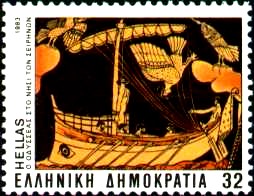
|
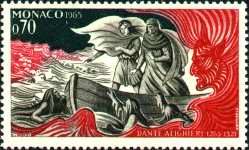
|
The Italian poet Dante Alighieri lived from 1265 to 1321. His mostly known
work is the 'Divina Commedia', Italian for 'divine comedy'. This poem
is about the way of the sinful soul from the depths of Hell over
the mountain of purification up to Paradise. The stamp depicts a part
of Hell, the attempt to reach the safe boat surrounded by the red
devil. Monaco and San Marino issued two Dante sets with maritime
motives.
|
|
To the left stamp you can see the Portuguese writer Luis de Camoes. He
lived from 1525 to 1580. He became known for glorifying the historic
deeds and discovery voyages of the Portuguese in his 'Lusiaden'. It is
the most famous epic poem of Portugal. On the right stamp you can see
a page of the 'Lusiaden' with the related picture. There are several
stamps about the 'Lusiaden' of Portugal and his colonies.
|
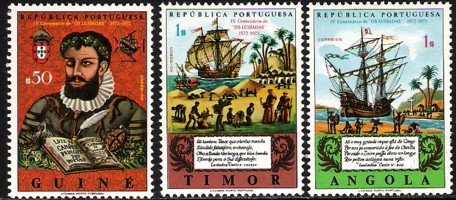
|
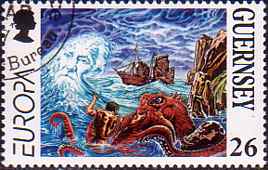
|
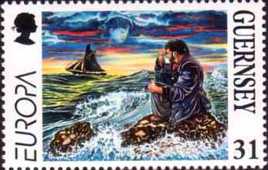
| |
The French writer Victor Hugo lived from 1802 to 1885. He was an
embittered opponent of Napoleon III and banished to live on the island
Guernsey from 1851 to 1870. Hugo wrote poems, dramas and novels and is especially
known for 'Notre Dame de Paris' (Hunchback of Notre Dame), 'Les Miserables'
(the Miserable Ones) and 'Les Travailleurs de la Mer' (Toilers of the Sea).
In 'Les Travailleurs de la Mer'
the main character Gilliatt performed incredible feats in salvaging a steam
engine and fighting against a storm and a polyp (left stamp), but
fails to confess his love to Deruchette. While she sails away with another one,
Gilliatt lets the tide flood over him, leaving himself to drown (right stamp).
The face of Victor Hugo is recognizable in the wave (stamp to the left).
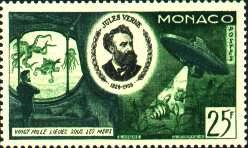
|
The French author Jules Verne lived from 1828 to 1905. He is known as
the founder of the utopian -technical adventure novel genre. Many of
his phantastic stories were visionary works and became true after his
death. One of his well known works, '20,000 Leagues under the Sea' is
illustrated on this stamp. To the right you can see the submarine
'Nautilus', to the left captain Nemo is watchin the sea animals.
France, Monaco, Guinee, Cameroon, Nicaragua, Panama and Mali all have
stamps about Jules Verne.
|
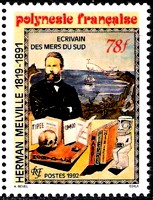
|
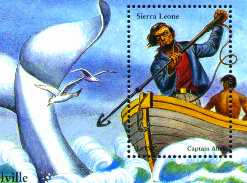
| |
The American novellist Herman Melville lived from 1819 to 1891. He was
a sailor on a whaler and later on served in the American navy.
Melville's writing had a very realistic style often complemented by
religious and poetic visions. To the left we see him on the Tahiti
stamp. To the right you can see a scene from his novel 'Moby Dick'. In
his obsessed chase for the white whale, captain Ahab is ready to throw
the harpoon.
|
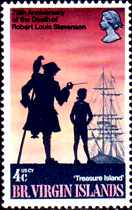
|
The English writer Robert Louis Stevenson lived from 1850 to 1894. He
wrote many Scottish adventure novels, stories about the South Sea and
critical letters. Stevenson gained worldwide fame with his novel about
the 'Treasure Island'. On this stamp you can see the main characters
of the book. The one-legged pirate Long John Silver with his parrot,
disguised as a cook and the ships boy Jack Hawkins. In the background
the schooner 'Hispaniola'. This stamp belongs to a set of four stamps
about the 'Treasure Island'. The Marshall Islands issued a block with
nine stamps about Stevenson and his Pacific voyages.
|
|
The English writer Daniel Defoe lived from 1660 to 1731. He originally
was an import merchant and as such, had to travel a lot around the
world. When he wrote his novel about 'Robinson Crusoe' in 1719 he
already was aged 60. Five years later he published his work 'A General
History of the Robberies and Murders of the most notorious Pyrates and
also their .....' under the pseudonym of "Captain Charles Johnson" in
London. The book was a great success and became the standard work
about piracy. In 1728 Defoe was even able to publish a successor.
Besides he wrote many scripts and letters about piracy. One of them is
depicted on this stamp about the pirate John Rackam along with
pictures of Mary Read and Anne Bonny. (See the Seemotive theme about piracy).
|
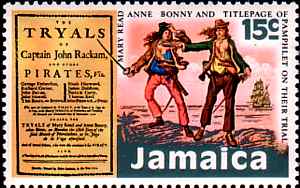
|
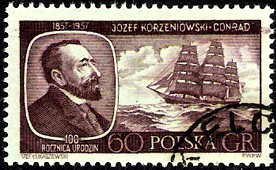
|
The Polish author Josef Conrad, full name Teodor Josef Conrad Nalecz
Korzeniowski lived from 1857 to 1924. When he was seventeen he went
aboard a barque at Marseille, first as a passenger, and from the
second voyage on as a ships boy. Conrad worked his way up and in 1886,
got the English captains certificate. During his time as a ship
officer he started writing. Since 1894 Conrad could make a poor living
by being a novellist only. But nevertheless, he became one of the
most important and greatest prose stylists and authors of the sea.
Besides many short stories there are novels like 'Lord Jim',
'Victory', 'The Shadowline', 'Typhoon', 'Chance', 'The Secret Agent',
'Under Western Eyes' .... etc.
|
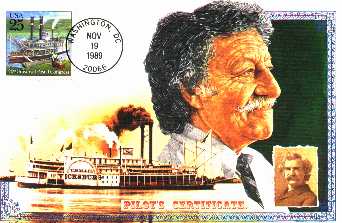
| |
The American Samuel Langhorn Clemens lived from 1835 to 1910. Since
1861 he called himself Mark Twain. He was a reporter, a novellist, a
social critic, a silver digger, a writer about voyages and a pilot.
Twain got the pilot license for the Mississippi and worked four years
between New Orleans and St. Louis. His new 'name' was derived from his
business: During heaving the lead to check the depht of the river the
deck-sailor called the marks at the lead line. 'Mark Twain' means two
marks and that was enough water for the Mississippi paddle steamers.
Besides the famous story 'Tom Sawyer und Huckleberry Finn', his 'Life
on the Mississippi' is Twains most important work in the fields of sea
literature.
|
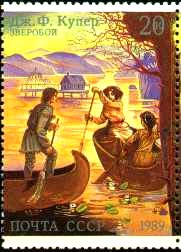
|
The American novelist James Fenimore Cooper lived from 1789 to
1851. For six years he served as an officer of the navy and published
over 50 works. They were all about history, stories about the sea and
many scripts about the indians. Cooper's most important novels are
'The Leatherstockings Tales', 'The Last of the Mohicans' and 'The
Pathfinder'. Surprisingly Russia has issued six stamps with images of
'The Deerslayer'. Here you can see the maritime stamp of this set.
|
|
The French poet Arthur Rimbaud lived from 1854 to 1891. It was a short
and violent life, reflected in his poems and prose. Rimbaud's verses
were hallucinatory and dreamlike, suggestive with rhythmic experiments
and negation of all truth. His so-called 'genious' works are
'Illuminations' and 'A Season in Hell'. Rimbaud also wrote a very
famous poem called 'The Drunken Boat'. It seems like this 'drunken
boat' is depicted on this stamp. Rimbaud wrote only for ten years and
then took up wandering through Europe and Africa. He died of cancer at
the age of 37 in a Marseille hospital.
|
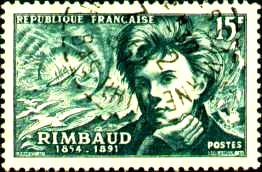
|
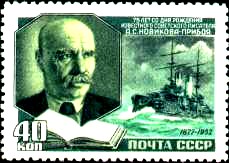
|
The Russian writer Aleksej Silytsch Nowikoff-Priboj lived from 1877 to
1944. In his novels and stories he told about the life on ships
travelling on the oceans of the world. Nowikoff-Priboj's widely known
work is the two volume book 'Tsushima'. In 1905 the Japanese destroyed
the Russian fleet in a gigantic naval battle at the islands of
Tsushima. The battle was never even as the Russians had quite a long
voyage. They had started in the Baltic Sea, rounded the Cape of Good
Hope at south Africa and reached the Yellow Sea totally exhausted.
Easy prey for the well-prepared ambush by the waiting Japanese war
ships.
|
|
The American novelist Ernest Hemmingway lived from 1899 to 1961. He
worked in an ambulance for the Red Cross during the first World War.
Later on Hemmingway changed to the infantry and was wounded heavily.
After the war he worked as a reporter and foreign correspondent, but
started to write novels and short stories as well. In 1954 Hemmingway
managed to win the Nobel Prize for literature. His most renowned
works are 'The Sun also Rises', 'For Whom the Bell Tolls', 'The Snow
of Kilimanjaro' and 'The Old Man and the Sea'. The contents of the
last novel is depicted on this stamp: an old fisherman in a small boat
is fighting against a huge fish. He wins the fight but then loses the
fish to the sharks. Cuba has published another Hemmingway stamp
depicting the same story.
|
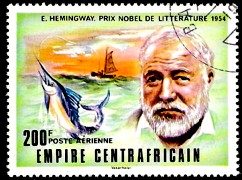
|
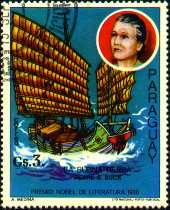
|
The American writer Pearl S. Buck lived from 1892 to 1973 and grew up
in China where her parents worked as missionaries. Later on she
married another missonary and got a Master of Arts at the university
of Nanking. Pearl Buck began to write in her twenties. She managed to
collect several awards, among them the Pulitzer Prize and the Nobel
Prize for Literature. Buck's most famous works are 'East Wind, West
Wind', 'All Men are Brothers', 'The Mother' and 'This Proud Heart'.
'The Good Earth' stood on the American List of 'bestsellers' for a
long time. The stamp to the left with the chinese junk should recall
this novel.
|
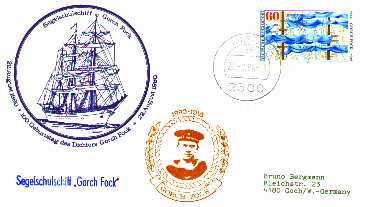
|
The German Gorch Fock was born in 1880 in Hamburg, Finkenwerder. His
real name was Johann Kinau. At first Fock wished to become a fisherman
like his father, but he was a slender boy lacking the strength
required for this job. He helped in a grocery and later on worked as
book-keeper. Still in young years he started writing stories about the
sea and plays for the theatre, most of them in the so called
'niederdeutsche' language, the common slang of the German coastal
regions. In 1912 he published his novel 'Seefahrt ist Not' (shipping
is necessary) which became a classic in German shipping literature.
Shortly thereafter his old dream of 'going to sea' seemed to become
true. In 1916 (during World War I) he was drafted into the German
navy. Only two months later he died in the 'Battle of the
Skagerrak'.
In remembrance two German navy training sailing vessels
were named after him. On this envelope you can see a cachet of the
second 'Gorch Fock' and a stamp to the centenary of his birthday.
|
|
This literature page shows another interesting aspect of collecting
maritime motives. There are much more stamps about writers and poets,
but of course we can't show them all as this page would become
endless. For example there are the French Baudelaire, the Finnish
Runoja and the German Leip. Having a look at myths and legends, the
famous 'Flying Dutchman' is waiting on many different stamps. And if
you want to start a collection about maritime painters you will find
plenty of motives as well.
|
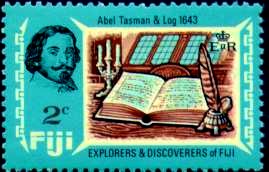
|
|
© 1998 - 2003 Bjoern Moritz, all rights reserved.
|